Welcome back to MyGardensBloom.com! Today, we’re turning the spotlight on a truly vibrant and eye-catching perennial: the Blanket Flower, scientifically known as Gaillardia Flower. Renowned for its dazzling, daisy-like blooms and long-lasting color, the Blanket Flower is a favorite among gardeners looking to add a burst of sunshine to their landscapes. Whether you’re a novice gardener or an experienced horticulturist, the Blanket Flower’s ease of care and striking appearance make it a must-have in any garden.
The Blanket Flower is native to North and South America, thriving in prairies and open meadows. It was named after the 18th-century French botanist Gaillard de Charentonneau. The common name “Blanket Flower” is said to be inspired by the plant’s vibrant colors, reminiscent of the patterns found in traditional Native American blankets.
Blanket Flowers are celebrated for their large, daisy-like blooms, which come in a variety of warm colors including red, orange, yellow, and bicolors. The petals often have a fringed appearance, adding to their unique charm. The plant features gray-green, lance-shaped leaves that are often covered in fine hairs, giving them a slightly fuzzy texture. Depending on the variety, Blanket Flowers can grow anywhere from 12 to 24 inches tall, making them ideal for borders, containers, and mass plantings.
Blanket Flowers have a long blooming period, typically from late spring to early fall. Their continuous display of bright flowers makes them a favorite for adding lasting color to gardens and attracting pollinators such as bees and butterflies.
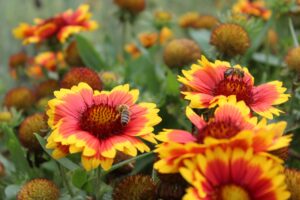
Popular Cultivars of Blanket Flower (Gaillardia)
Here are some of the most popular cultivars of Gaillardia that you can add to your garden for a splash of sunshine and a touch of variety.
Gaillardia ‘Arizona Sun’
‘Arizona Sun’ is one of the most popular cultivars, featuring fiery red petals with bright yellow tips. The flowers are large, measuring up to 3 inches in diameter. It grows to about 12 inches tall, making it ideal for borders and containers. This cultivar blooms from early summer to fall, providing a long season of color.
Gaillardia ‘Goblin’
‘Goblin’ is a compact cultivar with striking red and yellow blooms. The flowers are slightly smaller but very abundant. It grows to around 10-12 inches in height, perfect for the front of garden beds and rock gardens.
Gaillardia ‘Mesa Yellow’
‘Mesa Yellow’ offers vibrant, solid yellow blooms that brighten up any garden space. It has a more uniform growth habit and excellent drought tolerance. It reaches about 16-18 inches in height.
Gaillardia ‘Burgundy’
As the name suggests, ‘Burgundy’ features deep, wine-red flowers that create a stunning contrast in the garden. This cultivar grows to approximately 24 inches tall, making it one of the taller Gaillardia varieties. ‘Burgundy’ blooms from early summer to the first frost, offering an extended display of color.
Gaillardia ‘Fanfare’
‘Fanfare’ is unique for its trumpet-shaped petals that flare outwards, creating a pinwheel effect. The flowers are a mix of red, orange, and yellow. It typically grows to about 12-18 inches in height. This cultivar blooms from late spring to early fall.
Gaillardia ‘Arizona Apricot’
‘Arizona Apricot’ showcases soft apricot-yellow blooms with a hint of red at the base of the petals, providing a more pastel palette. It grows to about 12-14 inches tall.
Gaillardia ‘Sunset Cutie’
‘Sunset Cutie’ features bi-colored flowers with a red center and bright yellow tips, creating a striking display. It reaches around 10-12 inches in height, making it perfect for smaller garden spaces. This cultivar blooms from early summer to late fall, providing a long season of vibrant color.
Gaillardia ‘Oranges and Lemons’
‘Oranges and Lemons’ offers a unique color combination with soft orange petals that fade to yellow tips. The blooms are large and eye-catching. This cultivar grows to about 18-24 inches tall. It blooms from early summer to the first frost, ensuring a continuous display of color.
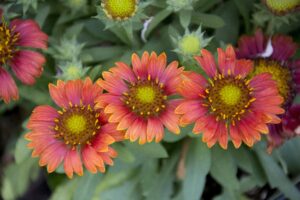
Sunlight Requirement of Gaillardia (Blanket Flower)
Gaillardia thrives best in full sun conditions. This means the plant should receive at least 6 to 8 hours of direct sunlight each day. Gaillardia’s bright and colorful flowers—ranging from reds and oranges to yellows and combinations thereof—require ample sunlight to develop their full color intensity and bloom profusely.
While Gaillardia performs best in full sun, it can tolerate partial sunlight. However, in partial shade conditions, expect fewer blooms and potentially less vibrant colors. If your garden spot receives less than the ideal amount of sunlight, try to ensure that Gaillardia gets at least 4 to 6 hours of direct sunlight daily, preferably during the morning to early afternoon when the sunlight is strongest.
Temperature and Humidity Requirements
Gaillardia is well-suited to a wide range of temperatures but performs best in warm conditions. Gaillardia thrives in temperatures between 70°F (21°C) and 85°F (29°C). These temperatures promote healthy growth and abundant flowering. Blanket Flowers are highly heat-tolerant and can withstand temperatures exceeding 90°F (32°C). They are well-suited for regions with hot summers and do not suffer from heat stress easily.
Gaillardia is also quite hardy in cooler climates. It can tolerate temperatures down to 40°F (4°C) and even lower in some cases. However, sustained frost or freezing temperatures can damage the plant, especially if it is not established or protected.
Gaillardia is hardy in USDA zones 3 through 10. In colder regions, it’s a good idea to mulch around the base of the plants to protect the roots from freezing temperatures during winter. Gaillardia is relatively adaptable to varying humidity levels but prefers moderate to low humidity.
Soil Requirements of Gaillardia (Blanket Flower)
The most crucial requirement for Gaillardia is well-draining soil. These plants are highly susceptible to root rot if the soil remains waterlogged. Sandy or loamy soils are ideal for ensuring proper drainage. Gaillardia prefers soil with a pH ranging from 6.0 to 7.5. This slightly acidic to neutral range supports optimal nutrient availability and uptake. While Gaillardia can tolerate a variety of soil types, they perform best in soils that are sandy or gravelly.
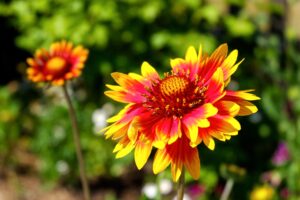
Propagation of Gaillardia (Blanket Flower)
Gaillardia, or Blanket Flower, is a versatile and hardy plant that can be propagated in several ways, including from seeds, cuttings, and division. Each method has its advantages and can be chosen based on your gardening preferences and the resources available.
Propagation from Seeds
Allow the flower heads to dry on the plant. Once they are dry, collect the seeds by gently shaking or rubbing the flower heads over a container. Remove any chaff or plant debris from the seeds to ensure they are clean.
Start seeds indoors 6-8 weeks before the last frost date. Fill seed trays or pots with a light, well-draining seed-starting mix.
Sow the seeds on the surface of the soil and lightly press them down. Do not cover the seeds with soil as they need light to germinate.
Mist the soil lightly with water to avoid displacing the seeds.
Place the trays in a warm, bright location. Seeds typically germinate in 14-21 days at temperatures between 70°F (21°C) and 75°F (24°C).
Once seedlings have developed a few sets of true leaves, they can be transplanted into the garden after the danger of frost has passed.
Propagation from Cuttings
Choose healthy, non-flowering stems for cuttings. The best time to take cuttings is in late spring or early summer.
Cut a 3-4 inch (7-10 cm) section of the stem just below a node (the point where leaves attach).
Remove the leaves from the lower half of the cutting. Dip the cut end in rooting hormone to encourage root development.
Insert the cutting into a pot filled with a well-draining potting mix. Water lightly.
Place the pot in a bright, indirect light location. Keep the soil moist but not waterlogged.
Roots should develop in 4-6 weeks. You can check for roots by gently tugging on the cutting. If you feel resistance, roots have formed.
Once the cuttings have rooted and are growing well, they can be transplanted into the garden.
Propagation by Division
The best time to divide Gaillardia plants is in early spring or early fall when the plant is not in active bloom.
Water the plant thoroughly the day before you plan to divide it to reduce stress on the plant.
Carefully dig up the entire plant, taking care not to damage the root system.
Use a sharp knife or garden spade to divide the root clump into smaller sections. Each section should have at least a few healthy shoots and a good portion of the root system.
Replant the divisions immediately in well-prepared soil, ensuring that the crown is at ground level. Water thoroughly to help the plants settle in.
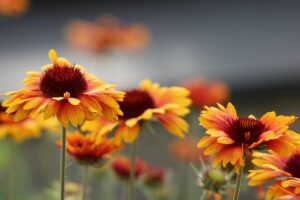
Water Requirement of Gaillardia (Blanket Flower)
When first planting Gaillardia, whether from seeds, cuttings, or divisions, water the plants thoroughly to help establish their root systems. Keep the soil consistently moist (but not waterlogged) for the first few weeks to encourage strong root development.
Once established, Gaillardia is quite drought-tolerant and requires less frequent watering. Water deeply but infrequently, allowing the soil to dry out between waterings. Typically, watering once every 7-10 days is sufficient, depending on the weather and soil conditions.
Fertilizer Requirements of Gaillardia (Blanket Flower)
Gaillardia is not a heavy feeder and can thrive in moderately fertile soil without excessive fertilization. In fact, too much fertilizer can lead to excessive foliage growth at the expense of flowers. When planting Gaillardia, you can incorporate a balanced, slow-release fertilizer into the soil. This provides nutrients gradually over time, supporting initial root establishment and early growth.
For established Gaillardia plants, an annual feeding in early spring as new growth emerges can be beneficial. Use a balanced fertilizer with equal parts nitrogen (N), phosphorus (P), and potassium (K), such as a 10-10-10 or 5-5-5 formulation.

Problems While Growing Gaillardia Flower
Growing Gaillardia, or Blanket Flower, is generally trouble-free due to its hardiness and adaptability. However, like any plant, it can encounter some issues. Here are common problems you may encounter while growing Gaillardia and how to manage them:
Fungal Diseases
Fungal diseases such as powdery mildew or leaf spot may appear as white powdery patches on leaves or brown spots with yellow halos. Ensure good air circulation around plants by spacing them adequately. Avoid overhead watering, as wet foliage can promote fungal growth. Apply fungicidal treatments if necessary, following label instructions carefully.
Root Rot
Yellowing or wilting leaves, stunted growth, and rotting roots are signs of root rot, typically caused by overly wet or poorly draining soil. Plant Gaillardia in well-draining soil and avoid overwatering. Improve soil drainage if necessary. Remove affected plants promptly to prevent spread.
Pests
Aphids, spider mites, and thrips can occasionally infest Gaillardia. Monitor plants regularly for signs of pests. Use insecticidal soap or neem oil to control minor infestations. Introduce beneficial insects like ladybugs or lacewings to naturally control pests.
Poor Flowering
Insufficient sunlight, overcrowding, or nutrient deficiencies can lead to poor flowering. Ensure Gaillardia receives at least 6-8 hours of sunlight daily. Thin out overcrowded plants to improve air circulation. Consider a light application of balanced fertilizer if growth appears stunted.
Overcrowding
Gaillardia can become overcrowded over time, leading to reduced airflow and increased susceptibility to diseases. Divide overcrowded clumps every few years in early spring or fall. Replant divisions in well-prepared soil to rejuvenate the plants and promote healthier growth.
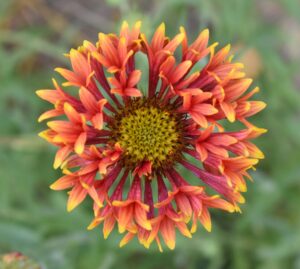
In conclusion, Gaillardia, or the Blanket Flower, embodies resilience and beauty in the garden. With its vibrant colors, low-maintenance nature, and ability to thrive in various conditions, Gaillardia is a perfect choice for both novice and experienced gardeners alike. By providing well-draining soil, ample sunlight, and minimal fuss, you can enjoy a cascade of cheerful blooms from spring through fall. Whether used as a border plant, in containers, or as part of a drought-tolerant landscape, Gaillardia adds a burst of color and charm that enhances any outdoor space. Discover the joy of growing Gaillardia and let its enduring appeal brighten your garden season after season.


